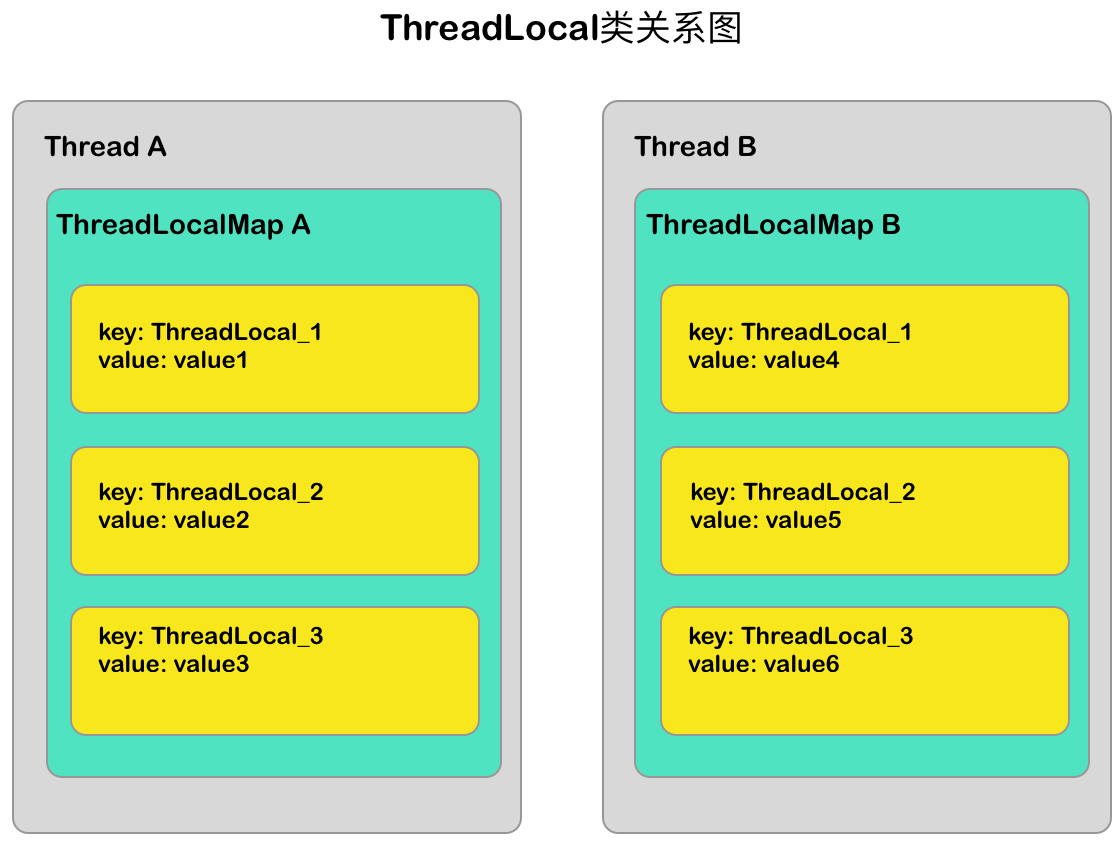概要
如果你还不知道threadlocal,那你就要了解一下,相信你一定会用到它。
作用
threadlocal最大作用就是提供线程级别的变量生命周期。
试想,如果你需要一个变量在一个线程的生命周期内都可以访问到,在不使用threadlocal的前提下你会怎么做?你或许这样做
提供一个类级别或者静态变量
但是这个方法大家很容易就想到在高并发时会出问题。把这个局部变量一直传递下去
但是如果你要调用的方法层次很深呢?难道你对每个方法都增加一个参数吗?显然不实际。
所以threadlocal就是提供了一个可行的方案,使得这个变量可以随时访问到,并且不会跟其他线程产生冲突。
使用
threadlocal的使用很简单,就是一个get, set。
1 | public class ThreadLocalTest { |
实现原理
set
我们先从set方法入手看看做了手脚。
1 | public void set(T value) { |
我们再看看ThreadLocalMap的创建及其他方法。ThreadLocalMap是定义在ThreadLocal里的一个静态类。
1 | ThreadLocalMap(ThreadLocal<?> firstKey, Object firstValue) { |
set方法比较简单,跟普通的Map差不多,把key和value set进去。
里面还包含了清理key为null的Entry对象的一些操作。
1 | private void set(ThreadLocal<?> key, Object value) { |
get
1 | public T get() { |
图解关系

可以看出相同的ThreadLocal在不同的线程有不同的值。
主要记住ThreadLocal是作为ThreadLocalMap的key,可能开始有点绕,但是慢慢思考,理清它们的关系就行了。
两个问题
内存泄漏 ?
这是一个对ThreadLocal来说老生常谈的问题了。那使用ThreadLocal为什么会导致内存泄漏?还有我们应该怎么去避免?是我们应该关注的两个点。
原因
首先,我这里假设大家对java的内存回收机制和引用(Reference)有一定的了解。如果不知道,请自行google了。
我们先看看ThreadLocalMap的Entry的定义
1 | //对key使用了WeakReference |
为什么要使用WeakReference?
网上很多的说法都说是使用了弱引用就会被GC一句带过,我觉得很多都说得不清不楚的。我通过自己的理解向大家解析一下:
其实很简单,从变量的作用域及引用关系的角度出发思考。试想如果一个ThreadLocal定义为一个类实例的变量或者是一个方法内的局部变量,那么当这个类实例被销毁了或方法退出了,在理想的情况下,垃圾回收器应该回收掉这个ThreadLocal是吧,毕竟它的生命周期已经完结了,但是如果这时ThreadLocalMap还是持有这个ThreadLocal的强引用的话,这个ThreadLocal就不会被回收,直到这个ThreadLocalMap被销毁或者这个线程被销毁。
说白了,从上面那个图看出,这样的设计导致的结果是这个ThreadLocal的生命周期跟线程的生命周期挂上钩了。
同时,这里又会出现另外一种内存泄漏的问题,即使ThreadLocal回收了,但是value没有被回收,还是会导致内存泄漏。但是你没办法把value设置为WeakReference,因为value不是你的,不归你管。
如何防止
ThreadLocal采用如下解决内存泄漏,看expungeStaleEntry方法。
1 | /** |
在ThreadLocal的源码你会看到很多清洗数据的代码最终都会调用到这个方法。这个方法主要逻辑,简单来说就是当key为null,把value也设置为null,从而让value也被回收。
这个方法的触发点有很多,当对ThreadLocal进行set,get,remove等操作时都会。
容器(如tomcat,netty)一般都是使用线程池处理用户到请求,此时用ThreadLocal要特别注意内存泄漏的问题,一个请求结束了,处理它的线程也结束,但此时这个线程并没有死掉,它只是归还到了线程池中,这时候应该清理掉属于它的ThreadLocal信息。
所以我们使用ThreadLocal一个比较好的习惯是在finally块调用remove方法。
hashcode和0x61c88647?
既然ThreadLocal用map就避免不了冲突的产生。
在ThreadLocalMap的构造方法中,我们可以看到以下代码
1 | //table的下标的计算方式 |
1 | //threadLocalHashCode的定义 |
从代码可以看出每个ThreadLocal的实例的threadLocalHashCode的差值为0x61c88647这么多,那为什么要这样做呢?
这个魔数的选取与斐波那契散列有关,0x61c88647对应的十进制为1640531527。
斐波那契散列的乘数可以用(long) ((1L << 31) * (Math.sqrt(5) - 1))可以得到2654435769,如果把这个值给转为带符号的int,则会得到-1640531527。换句话说
(1L << 32) - (long) ((1L << 31) * (Math.sqrt(5) - 1))得到的结果就是1640531527也就是0x61c88647。
通过理论与实践,当我们用0x61c88647作为魔数累加为每个ThreadLocal分配各自的ID也就是threadLocalHashCode再与2的幂取模,得到的结果分布很均匀。
ThreadLocalMap使用的是线性探测法,均匀分布的好处在于很快就能探测到下一个临近的可用slot,从而保证效率。。为了优化效率。
简单来说就是在table[]的size为2的次幂情况下,取模会得到均匀分布。
一个优化点
从上面得知,ThreadLocal的Map可能会产生冲突,解决冲突的办法是线性探测。
而Netty的FastThreadLocal的利用了一个自增序号来作为下标,避免了冲突的产生。
1 | public FastThreadLocal() { |